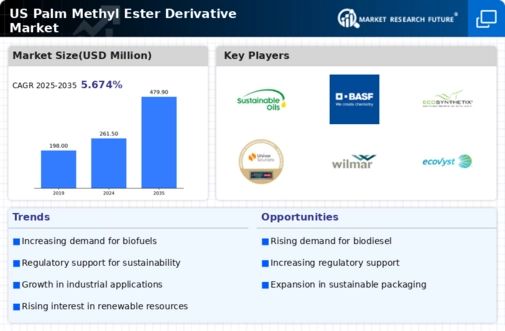The competitive landscape of the US Palm Methyl Ester Derivative Market is characterized by a dynamic interplay of established players and emerging companies, all of which are striving to expand their market share and develop innovative solutions. The increasing demand for bio-based products, driven by sustainability concerns and governmental regulations favoring renewable resources, has positioned palm methyl esters as a sought-after product in industries ranging from personal care to industrial applications. Companies are focusing on enhancing their production efficiencies and developing environmentally friendly processing technologies to cater to the growing preferences for sustainable alternatives.
With both local and global players vying for dominance, understanding market trends, customer preferences, and regulatory frameworks is vital for businesses looking to capitalize on growth opportunities in this sector.Dow Chemical has established a strong presence in the US Palm Methyl Ester Derivative Market through its commitment to innovation and sustainability. The company leverages its extensive research and development capabilities to produce high-quality methyl ester derivatives that meet the stringent performance and environmental standards established by various industries.
Dow Chemical's strategic partnerships and collaborations with other industry players have allowed it to bolster its market position and enhance its product offerings tailored for specific applications. The company's emphasis on customer-centric solutions and its robust distribution network are key strengths that contribute to its competitive advantage in the palm methyl ester derivatives space, enabling it to effectively respond to market demands while promoting environmentally sustainable practices.Sustainable Oils has positioned itself as a leader in the US Palm Methyl Ester Derivative Market with a clear focus on sustainability and innovation.
The company specializes in producing bio-based methyl ester derivatives and emphasizes the use of responsibly sourced palm oil, reflecting its commitment to environmentally friendly practices. Sustainable Oils offers a range of key products, including bio-lubricants and surfactants, that are well-received in various industries across the US. The company's strengths lie in its ability to adapt and meet customer needs through tailored solutions, as well as its proactive approach towards mergers and acquisitions, which have enabled it to expand its technological capabilities and market reach.
By fostering collaboration with other industry stakeholders, Sustainable Oils is effectively enhancing its competitive edge and solidifying its presence in the palm methyl ester derivative sector within the United States.




















Leave a Comment